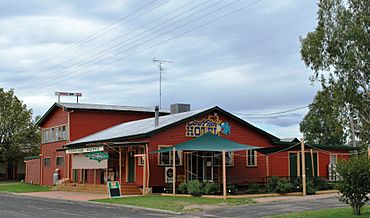Yetman, New South Wales facts for kids
Quick facts for kids YetmanNew South Wales |
|
|---|---|

The Codfish Hotel
|
|
| Population | 207 (2016 census) |
| Postcode(s) | 2410 |
| Elevation | 257 m (843 ft) |
| Location | |
| LGA(s) | Inverell Shire |
| State electorate(s) | Northern Tablelands |
| Federal Division(s) | New England |
Yetman is a small town, also called a hamlet, in northern New South Wales, Australia. It is located in the New England region. In 2006, about 178 people lived in Yetman and the areas around it.
The town sits by the Macintyre River. It is about 30 kilometers (19 miles) south of the Queensland border. Yetman is also about 701 kilometers (436 miles) north of Sydney. It is a meeting point for roads leading to Tamworth, Tenterfield, and Boggabilla.
Contents
Yetman's Past: A Look Back
Early Days and First Settlers
Long ago, the land around Yetman was home to the Bigambul people. They are a group of Aboriginal people. They used to fish along the Macintyre River.
In 1837, a large farm called Yetman Station was started. The Dight family set it up. They followed a path explored by Allan Cunningham.
Hotels and Community Life
The first two hotel licenses were given out in 1866. This was around the same time the first store was built. The Yetman Hotel was first, then the Macintyre Hotel. William Watson Rainbow built and ran the Macintyre Hotel.
Hotels in the countryside were often the main social places. The Macintyre Hotel was no different. Its porch was even used by racing officials during the Easter Races in 1870. New Year and Easter Races brought everyone together. Farm owners and workers enjoyed the races, betting, and special dinners. The hotel owner often hosted these dinners and gave out prizes. The Macintyre Hotel is no longer there. The Yetman Hotel later became what is now known as the Codfish Hotel.
Schools, Post, and Police
The first public school in Yetman opened in 1867. Local people, including William Watson Rainbow, asked for it. The Yetman Post Office also opened on September 1, 1867. Richard Holmes, who ran the Yetman Hotel, became the first Postmaster.
In 1874, the first police station was built. St Andrews Church was built in the 1870s. It was used by both Presbyterian and Anglican church groups.
Farming and Growth
Yetman has always been known for raising beef cattle and horses. Later, sheep, wool, and timber industries also grew. In the 1920s, thick areas of scrub, full of rabbits and prickly-pear plants, were cleared. This hard work made the land ready for farming.
By the 1950s, growing wheat became very successful. It is still a major crop today. Some crops are also grown on the rich, dark soils near the river.


